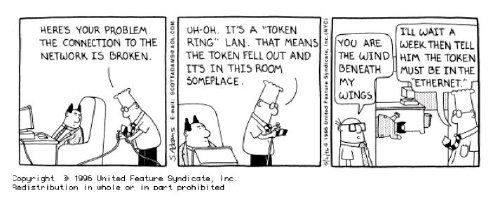
Digital Equipment Corporation co-founder and CEO Ken Olsen (Digital Equipment image).
Posted on 02/08/2011 5:46:22 AM PST by Red Badger
Obituary Ken Olsen, the founder of minicomputer and client/server company Digital Equipment Corporation (DEC) died on Sunday. He was 84 years-old.
Olsen started out a maverick, pioneered and drove the minicomputer and supermini revolutions, and then became a dinosaur. But unlike many other senior DEC executives he remains a much-loved and revered figure based on what he did and even taking into account what he stopped DEC from doing.
His legacy lives on at HP, which bought Compaq, which bought DEC, and at Xiotech, where Steve Sicola's ISE team started at DEC. Ken Olsen was an engineer first and foremost. He was born on 6 February, 1926, the son of Norwegian and Swedish parents, and served in the US Navy from 1944 to 1946. After the war he went to MIT and achieved a BSc and then an MA in electrical engineering.
He gained experience there with transistorised computers and started up DEC with co-founder Harlan Anderson in 1957 at an old mill in Maynard, Massachusetts. IBM was then riding high and Olsen and Anderson were upstart mavericks who thought they could build better and much more affordable computers than IBM's mainframe behemoths which dominated IT at that time.
The two gained $70,000 seed financing from George Doriot's American Research and Development Corporation and set to work. Olsen worked on and received patents for a switch, a line printer buffer and magnetic core memory in the 1960s.
To avoid competitor radar screens, the first computing product was not called a computer. Instead DEC called it a PDP, a Programmable Data Processor. It was an 12-bit machine, and used ribbons of paper tape to control it. The PDP had a colourful front switch panel – the switches could be used to set register values.
It became popular in university labs because it was vastly cheaper than a mainframe, ran real-time programs instead of batch jobs, and didn't need a raised floor, air-conditioned data centre, being just another piece of lab equipment.

Digital Equipment Corporation co-founder and CEO Ken Olsen (Digital Equipment image).
Ping..........
may he RSTS/E in peace.
I assert it was an 8 bit machine. We used a PDP-4 with 4K of static ram (which was toroids wired appropriately). I believe that the US Coast Guard was the first group to take a PDP-4 to sea on the CGC Evergreen, and used it to process oceanographic data. Then about two years later came the 8-S, which you could carry under your arm with 8 K of static ram. No installation was required- clear the desk space and plug it in. This was really the machine that started things going. PAL was the programming assembly language that one had to work in to jam the program into the limited RAM. We could do both floating and fixed point arithmetic.
I am sorry to hear that he died. May he rest in peace.
I was a VAX/VMS systems programmer back in the day. DEC was the trailblazer for client server computing.
Olsen was a rock star in nerdville.
My first “internet” transmission was in 1983 using a DEC PDP 1100.
RIP Ken. Ya done good.
No one's perfect...
Mine was in the back seat of a 72 Buick....oh, wait, nevermind..........
Holy cow! that’s some old equipment.
Anyone remember what it’s like to “finger bone” boot code?

Brings me back to the days when I coded FORTRAN on a green screen connected to a VAX at 2 in the morning since that was the only time the school’s computer center was relatively quiet.
Thank you for the career Mr. Olsen.
The PDP series — at least the ones I worked with, starting with the PDP8e — were 12-bit designs, and programming machine code was in octal, (base-8) rather than hexadecimal.
(P.S. Wikipedia also says 12-bit architecture...)
That’s 32 gauge wire. The girls in Core Memory worked under microscopes. A PDP-1 came into the OEM in Woburn. It went to the Computer Museum in Boston. I worked on 11/04 up to J-11 based systems. Ah, Unibus. Badge #76000.
One of the Assemblers has his face cut out and pasted on a photo from Dawn of the Dead. He got away with it for two years.
There was a time in my life when I became an expert at developing software OpenVMS and worked for quite some time with good pay doing it.
It was (and still is) one of the most robust, reliable and almost unhackable piece of engineering marvel I’ve ever had the pleasure of working with.
Unfortunately, its days are numbered. I don’t think its current owner, Hewlett Packard plans to market it with enthusiasm.
But anyway, thank you Ken for giving me several years of steady work with you wonderful product. You might have made lots of business mistakes, but you helped to create one hell of an operating system (which in my mind, should have been the king of the hill instead of the ones we have to contend with today).
I was there when Palmer took over, but resigned soon after.
Digital could never reconcile the split between engineering and management.
Rest in Peace Ken.

Digital could never reconcile the split between engineering and management.
As I recall, the cheeseburgers in DEC cafeterias were big and juicy.
Would ya consider Gary Kildall (sp) another ‘forgotten’ part of computer history?
Disclaimer: Opinions posted on Free Republic are those of the individual posters and do not necessarily represent the opinion of Free Republic or its management. All materials posted herein are protected by copyright law and the exemption for fair use of copyrighted works.